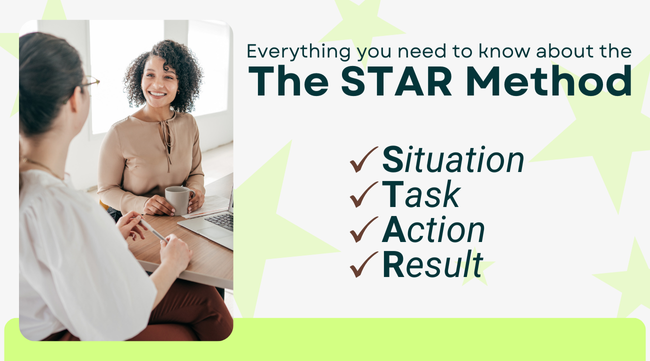
No matter the length of your career, interviewing for a job is bound to fray your nerves in some capacity. Being nervous is normal and a sign that you care about the opportunity and making a good impression. The most important thing you can do in a job interview is tell your story in a clear, concise, and well-structured way. Regardless of how well you interview, the STAR method is an excellent technique for communicating your value, articulating your experience and skills, and staying on track while responding to behavioral interview questions.
What is the STAR Method for Interviews?
The STAR method is an acronym for Situation, Task, Action, Result. A 2-3 minute structured response to behavioral interview questions (for example, “Tell me about a time you had a conflict with a coworker and how you resolved it”). Using this technique, the response would be structured as follows:
- Situation: Describe the situation to give the interviewer context of what happened
- Task: Explain the role you played in the situation
- Action: Detail each step you took towards resolution
- Result: Share the outcome achieved
Benefits of the STAR Method for Job Seekers
When used appropriately, job seekers can make a positive impression. Using the STAR method, candidates follow the specific structure to stay on track while sharing compelling anecdotes and painting a picture of the event. This technique helps to communicate the response concisely and avoid rambling.
Recruiters who favor STAR responses are invested in the candidate’s experience. It’s easy to ask questions that deem a “yes” or “no” answer and move on. However, it requires deep listening skills and attentiveness to understand someone’s perspective and make them feel valued and heard.
Why Interviewers Favor the STAR Method
The STAR method is a great predictor. A recruiter and/or hiring manager can see that a candidate has specific skills or experiences from their resume. However, the resume gives no context into how the candidate applies the skills or handles situations. Responses in the STAR format allow the interviewer to predict how the candidate would succeed in the job. While traditional interview questions tend to be about 10% effective, behavioral questions are 55% effective.
Interviewers also favor STAR responses because they prevent candidates from memorizing answers to common interview questions and saying what they think the interviewer wants to hear instead of personalized and authentic anecdotes. GenAI has transformed how job seekers prepare for interviews, which has made it incredibly challenging for recruiters to assess their actual capabilities and expertise. This has prompted interviewers to conduct more behavioral interviews, seeking evidence-based responses.
How to Prepare for an Interview Using the STAR Method
You may be thinking, how can I prepare to answer this way when I don’t know the questions they’ll ask? A combination of practicing your stories for the most common behavioral questions asked in interviews and a thorough review of the job description should set you up for success. Here are a few tips to get you started.
- Review the job description. Identify the qualities critical to the role’s success and choose examples from your past that demonstrate your experience. For example, if this role leads a team, choose a story that exemplifies a time you lead a team to success.
- Prepare examples for commonly asked questions. Here is an excellent compilation of 30+ common behavioral interview questions to prep and practice with.
- Practice your responses. Whether you talk out loud to yourself or do mock interviews with someone who can provide feedback, it’s crucial to practice responding using the STAR method, especially if it’s your first time using this technique.

Familiarizing yourself with the STAR method can boost your interview performance and increase your chances of landing a great job. By structuring your responses around Situation, Task, Action, and Result, you present your experiences clearly and effectively, showcasing your unique value to prospective employers.
For more interview tips, subscribe to The JOHNLEONARD Blog below and download our FREE Job Seeker Survival Guide!
